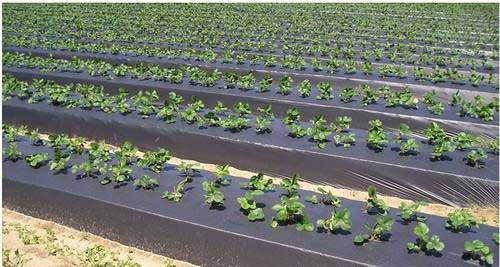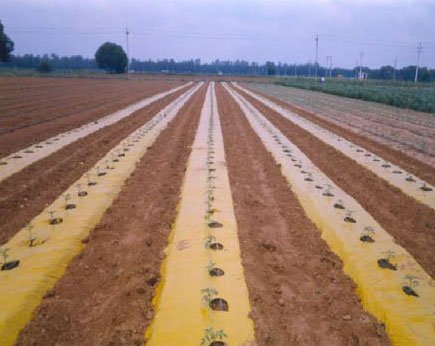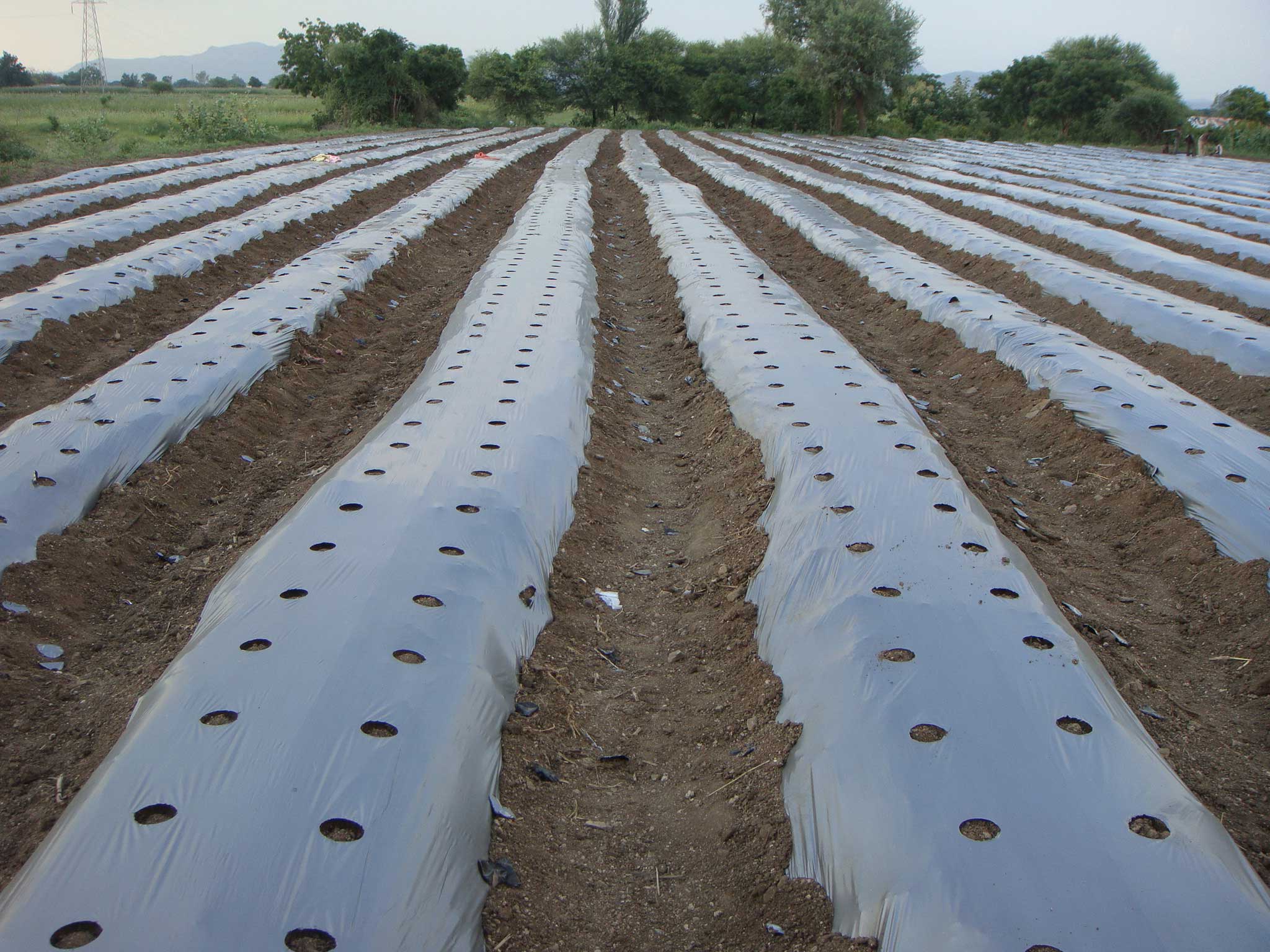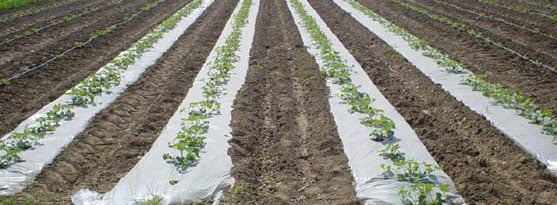Mulching means it is a process of covering the soil and make more favorable conditions for plant growth, development.
Mulching is forming the protective layer around the plant. The practice of applying mulch is an ancient and effective technique.
It is beneficial for plant health while it is creating a microclimate around the plant root zone.
Advantages of mulching
water conversion and weed control are the main benefits of mulch and many other advantages in agriculture. These are as follows
- Water conversion –
It prevents the direct evaporation of soil water; hence crops required less water. - Weed control –
This is the most important motive behind many farmers using mulching techniques. It helps to suppress weed growth. - Soil moisture –
It helps prevent water in the soil from evaporating and maintaining soil moisture for a long time, and preserves the plant root zone’s constant humidity level. - Root development-
It creates a microclimate near the root zone; it helps the white root development of the plant on the upper surface of the soil. - Substrate for plants, flower, and fruit –
The mulching films prevent direct contact between soil and flower, fruit, and other plant parts, helping improve flower and fruit quality. - Pest control –
The mulching film reflects light, so pests like aphids and thrips, leafminer so easy to control. It is also very effective against nematode. While- Yellow mulching films attract whitefly help to control whitefly growth. - Heat and cold insulator –
The mulching film acts as a heat and cold insulator in winter; mulch helps prevent soil from rapidly freezing, while in summer, it helps control soil temperature. - Soil erosion –
Mulching becomes a barrier between soil and raindrop and slows down the soil erosion process. - Salinity level –
It is observed that there less salinity level around the dripper where mulch-film is used.
 Type of mulching
Type of mulching
Generally, mulching has two main types organic mulching and inorganic mulching both mulch having own advantage.
Organic mulching
An organic mulch is made up of natural materials such as paddy straw, wheat straw, bark, dry grasses, wood chips, dry leaves, pine needles, sawdust, grass clipping, etc.
But this organic mulch material gets decomposed easily and needs frequent replacement, and attracts insects, slugs, and cutworms.
Straw Mulch

Image source –www.todayshomeowner.com
This is the most common material used, organic mulch. Paddy and wheat straw is the most common mulching materials used for vegetable crops and fruit crops.
Among organic mulching materials, straw has a long life compared to other mulches like grasses, leaves, and sawdust.
Paddy straw and wheat straw after decomposition makes the soil more fertile.
Grass Clipping Mulch
This is one of the most easily available material: green grass or dry grass used for grass clipping. After decompose, grass provides nitrogen to the soil. In the rainy season, green grass development of its root system, so my suggestion uses dry grass for mulching.
Limitation of Organic Mulching
- organic mulch sometimes adversely affects poorly drained soil; it makes the soil too moist; hence, the oxygen level near the root zone decreases.
- Many organic types of mulches provide shelter for insect snails and mice.
- Grass and straw mulch contain seeds so that they may become weeds.
Inorganic mulching
In Inorganic mulching, materials like plastic films, geotextiles, Gravel, and pebbles can be used as inorganic mulch.
Inorganic mulches are extensively used in commercial agriculture. Plastic mulch is the most common material used among all inorganic mulches. It does not decompose easily.
Plastic Mulch
Plastic mulch is made up of polyethylene material; using plastic in agriculture is called plasticulture.
In plastic mulching, various types of plastic mulching are available according to crop and need.
Clear plastic mulch
This type of mulch allows the soil to warm. This mulch is mostly used in the cooler area; if you take the crop a little early, then use this clear mulch this mulch useful for strawberry cultivation in the winter season.
Black Mulch

As the name suggests in black mulch, both side of this is black in colour. This mulch doesn’t transfer any light. It helps in conserving moisture, controlling the weed.
Yellow- Brown Mulch

In this type, the brown side is touching the soil, and the yellow is facing upward. It is used in the area where you have a lot of infestation of whitefly. Yellow colour attracts whitefly so when whitefly come into contact with mulch due to sun heat they killed.
silver- black Mulch

Silver- black, very popular, most popular in the farmer. This mulch suitable for almost every crop. This mulch reflects 27% of the light to the fruits and plant; it improves color development. It is observed that Pomegranate and strawberry fruits are more premontane in colour.
White – black Mulch

This is my favourite is mulch because, after serval experiment, we found that white mulch shows a more healthy plant than black and silver mulch.
White-black mulch transferred more than 60% of the photoactive radiation back to the plant hence enhancing the plant growth, and the plant becomes thickest and stronger leave with lesser insect and pest attack and disease.
Therefore, you get higher production. In summer, it performs better.
How to select good mulching
Selecting the right mulch martial is an important decision for the farmer. To get maximum benefits from mulching right mulch film must be select.
Thickness
For vegetable crops, film thickness ranges from 15 microns to 30 microns, while for orchids crops, film thickness ranges from 100 microns to 150 microns.
Depend Upon crop type, select a proper thickness. For vegetables, the crop chooses 30 microns if you are using over one year; in the case for a small duration, the crop uses 25 microns.
For an Orchard crop where longer durability is needed, if the soil contains so much stone, select 150-micron film; otherwise, select 100-micron film.
Test mulching film
Take a small plastic mulching paper to check it against the sunlight; if it is transferring the light, don’t ever use it.
Buy quality materials from the right sources.
A good mulching paper possesses long durability, airproof and Thermal proof ( they don’t pass any light or very less light ) characteristic. In India, only a few mulching manufacturing companies follow this parameter, So buy the mulching film from the renowned source.
list of crop showing high yield after using plastic mulch
| Vegetable crop | Orchard crop |
|---|---|
| Cabbage | Pomegranate |
| Cauliflower | Lemon |
| Capsicum | orange |
| Tomato | Banana |
| Brinjal | Peach |
| Chilli | Guava |
| Bhendi | Papaya |
| Potato | Apricot |
| Grapes |
How to install mulching
In vegetables, crop mulching should be done at the time of bed preparation, but it should be done just after plantation in Orchard crops.
- Mark the rows in the field before the installation of mulch film.
- Prepare the primary bed.
- Apply Farm Yard Manure and a basal dose of 100 kg DAP and 10:26:26+ MgSO4 @ 50kg per acre. Mix the FYM thoroughly in soil with the help of a rotavator.
- Prepare the final beds with top width 75-90 cm for two-row crops like Capsicum, Cauliflower, Cabbage and for single row make top width 45-60 cm for crops like Tomato, Brinjal, Chilli, Cucumber.
- Before installation, make sure that the bed is flat and remove the previous plant materials like big stone, branches, stem, etc., which can damage the mulch.
- Put drip lateral on the bed and check they are working or not.
- Install the mulch film by stretching evenly on the beds manually or mechanically such that the mulch settles well on the bed.
- Cover the corners of the mulch film (up to 20 cm from both mulches ends) along the bed length in soil (Tip – the darker side of mulch always facing toward soil)
- make a hole with the help of a hot pipe or stainless steel glass.

conclusion
Use mulch for boosting crop yields and productivity.
Use only quality martial and according to crop need. If you have any quires, suggestions, please comment.





how to determine microns from the mulching sheet that it is 30 micron or 25 micron etc
Hello Ram,
check the cover of the mulching paper thickness of the mulching paper is mained
Sir can we use Mulching for the Pineapple crop.
Yes,
mulching suitable for Pineapple crop
Sir in our field there is lot of nut grass (motha), so what micron should we use for tomato farm
You can use 25-30 micron mulching film.
What micron should I use for strawberry plants ?
Which is very ideal for strawberry plants sliver – black or white – black ?
15-25 micron, sliver-black
Very good training
Can we reuse mulching sheet for other crop if used once for chilli crop
yes
Informative read on mulching films! They’re a game-changer for farmers.
Sir,
Can I use mulching without drip irrigation with flood irrigation???
Hello Mayur,
For plastic Mulching Drip irrigation is must required.